1996 CHEVROLET ASTRO seats
[x] Cancel search: seatsPage 19 of 372
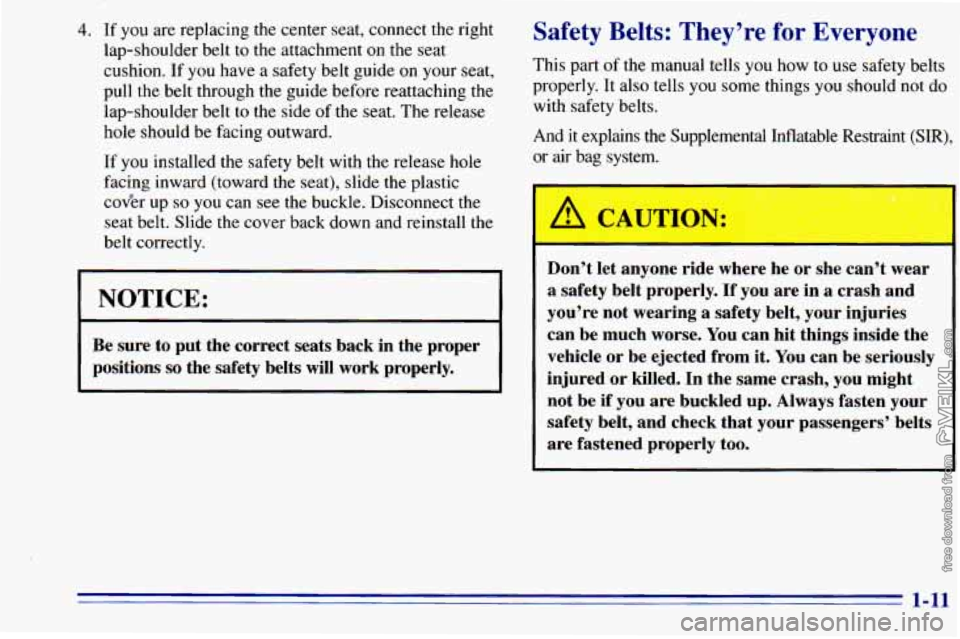
4. If you are replacing the center seat, connect the right
lap-shoulder belt to
the attachment on the seat
cushion. If you have a safety belt guide on your seat,
pull the belt through the guide before reattaching the
lap-shoulder belt to the side of the seat. The release
hole should be facing outward.
If you installed the safety belt with the release hole
facing inward (toward the seat), slide the plastic
cov’er up
so you can see the buckle. Disconnect the
seat belt. Slide the cover back down and reinstall the
belt correctly.
NOTICE:
Be sure to put the correct seats back in the proper
positions
so the safety belts will work properly.
Safety Belts: They’re for Everyone
This part of the manual tells you how to use safety belts
properly. It also tells you some things you should not
do
with safety belts.
And
it explains the Supplemental Inflatable Restraint (SIR),
or air bag system.
Don’t let anyone ride where he or she can’t wear
a safety belt properly. If you are in a crash and
you’re not wearing a safety belt, your injuries
can be much worse. You can hit things inside the
vehicle or be ejected from it. You can be seriously
injured or killed. In the same crash, you might
not be if you are buckled up. Always fasten your
safety belt, and check that your passengers’ belts
are fastened properly
too.
Page 24 of 372
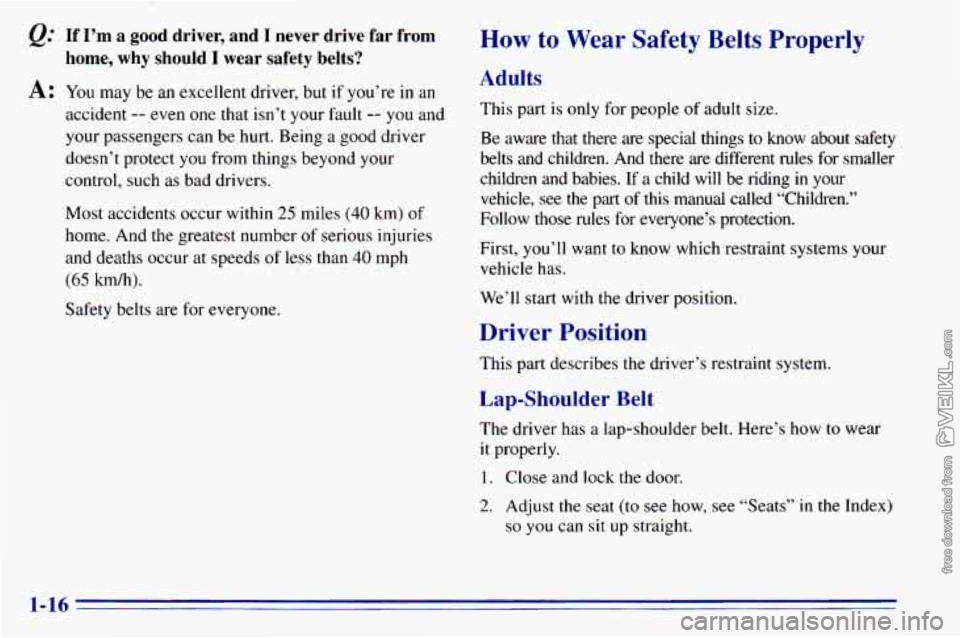
@ If I’m a good driver, and I never drive far from
A: You may be an excellent driver, but if you’re in an
home, why should I wear safety belts?
accident -- even one that isn’t your fault -- you and
your passengers can be hurt. Being
a good driver
doesn’t protect
you from things beyond your
control, such as bad drivers.
Most accidents occur within
25 miles (40 km) of
home. And the greatest number of serious injuries
and deaths occur at speeds
of less than 40 mph
(65 km/h).
Safety belts are for everyone.
How to Wear Safety Belts Properly
Adults
This part is only for people of adult size.
Be aware
that there are special things to know about safety
belts and children. And there are different rules for smaller
children and babies. If a child will be riding
in your
vehicle, see the part
of this manual called “Children.”
Follow those rules for everyone’s protection.
First,
you’ll want to know which restraint systems your
vehicle has.
We’ll start with the driver position.
Driver Position
This part describes the driver’s restraint system.
Lap-Shoulder Belt
The driver has a lap-shoulder belt. Here’s how to wear
it properly.
1. Close and lock the door.
?. Adjust the seat (to see how, see “Seats” in the Index)
so you can sit up straight.
1-16
Page 42 of 372
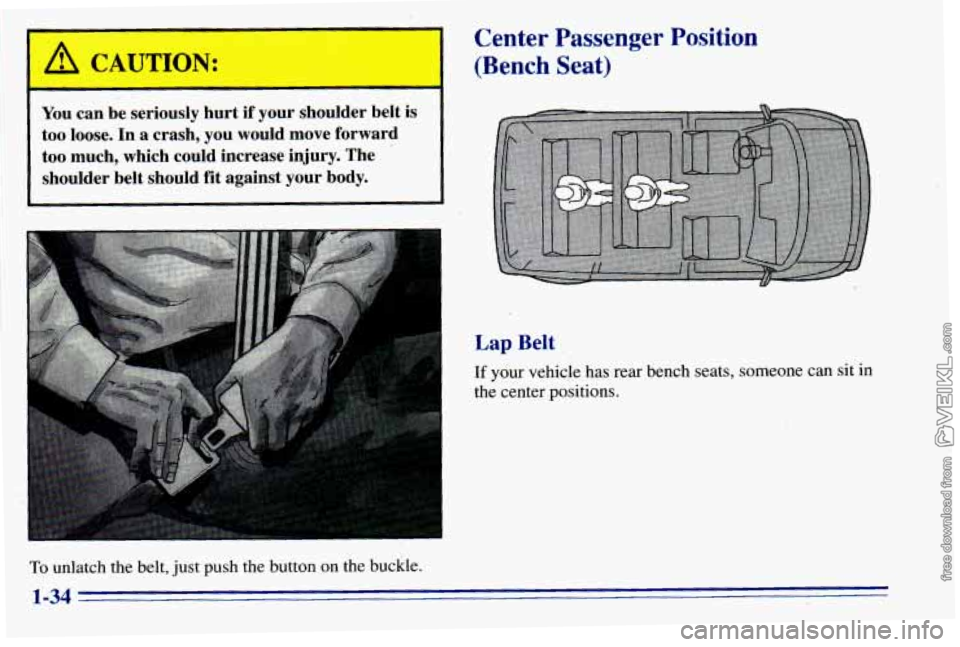
I A CAUTION:
t -
You can be seriously hurt if your shoulder belt is
too loose. In a crash, you would move forward
too much, which could increase injury. The
shoulder belt should
fit against your body.
c
..
To unlatch the belt, just push the button on the buckle.
Center Passenger Position
(Bench Seat)
I Lap Belt
If your vehicle has rear bench seats, someone can sit in
the center positions.
1-34'
Page 44 of 372
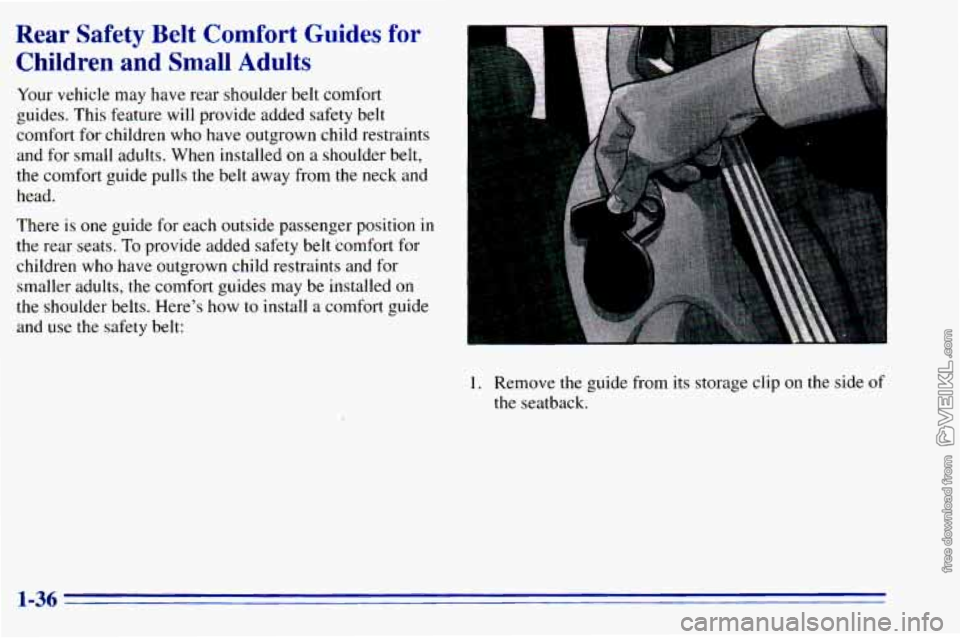
Rear Safety Belt Comfort Guides for
Children and Small Adults
Your vehicle may have rear shoulder belt comfort
guides. This feature will provide added safety belt
comfort for children who have outgrown child restraints
and for small adults. When installed on a shoulder belt,
the comfort guide pulls the belt away from the neck and
head.
There is one guide for each outside passenger position in
the rear seats. To provide added safety belt comfort for
children who have outgrown child restraints and for
smaller adults, the comfort guides may be installed on
the shoulder belts. Here's how to install a comfort guide
and use the safety belt:
1. Remove the guide from its storage clip on the side of
the seatback.
1-36
Page 55 of 372

A ch 1 a rear-fac lg child ;traint can be
seriously injured
if the front passenger’s air bag
inflates. This is because the back of a rear-facing
child restraint would be very close to the inflating
air bag.
If your vehicle is a passenger van, always
secure a rear-facing child restraint in
a rear seat.
If your vehicle is a cargo van, do not use a
rear-facing child restraint in this vehicle.
If a
forward-facing child restraint is suitable for your
child, always move the passenger seat as far back
as it will go.
You’ll be using
the lap-shoulder belt. See the earlier part
about the top strap if the child restraint has one.
1. Because your vehicle has a front passenger air bag,
always move
the seat as far back as it will go before
securing a forward-facing child restraint. (See
“Seats”
in the Index.)
4. Pick up the latch plate, and run the lap and shoulder
portions
of the vehicle’s safety belt through or
around the restraint. The child restraint instructions
will show
you how.
If the shoulder belt goes in front
of the child’s face or
neck, put it behind
the child restraint.
2. Put the restraint on the seat. Follow the instructions
3. Secure the child in the child restraint as the positioned so you would be able to unbuckle the
for
the child restraint.
5. Buckle the belt. Make sure the release button is
instructions say. safety belt quickly if you ever had to.
1-47
Page 181 of 372
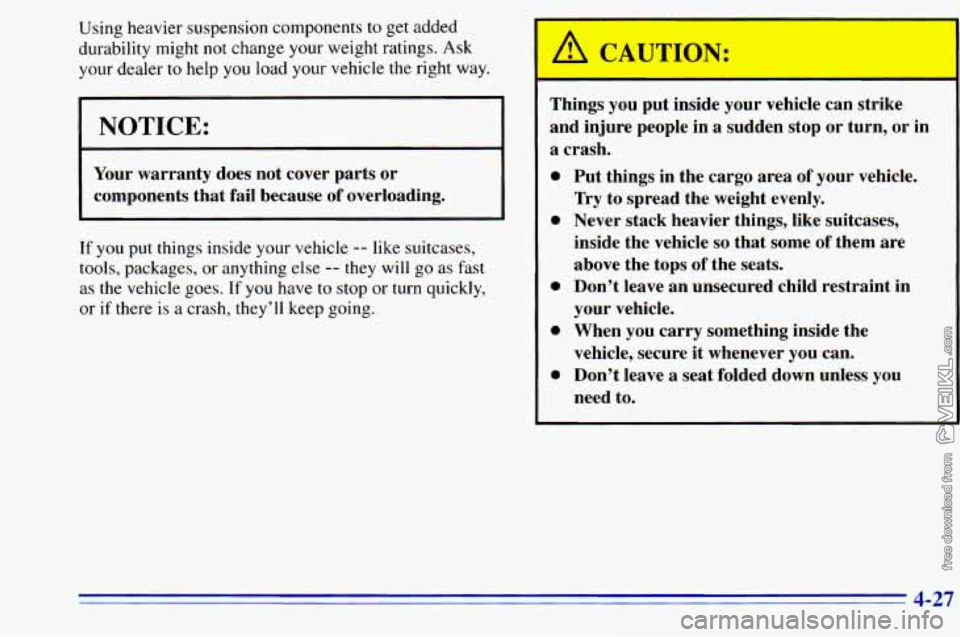
Using heavier suspension components to get added
durability might not change your weight ratings. Ask
your dealer
to help you load your vehicle the right way.
I NOTICE:
Your warranty does not cover parts or
components that fail because of overloading,
If you put things inside your vehicle
-- like suitcases,
tools, packages, or anything else
-- they will go as fast
as
the vehicle goes. If you have to stop or turn quickly,
or if there is a crash, they’ll keep going. Things
you put inside your vehicle
and injure people in a sudden stop
or turn, or in
a crash.
0
0
0
0
0
Put things in the cargo area of your vehicle,
Try to spread the weight evenly.
Never stack heavier things, like suitcases, inside the vehicle
so that some of them are
above the tops of the seats.
Don’t leave an unsecured child restraint in
your vehicle,
When you carry something inside the
vehicle, secure it whenever you can.
Don’t leave
a seat folded down unless you
need to.
4-27
Page 245 of 372
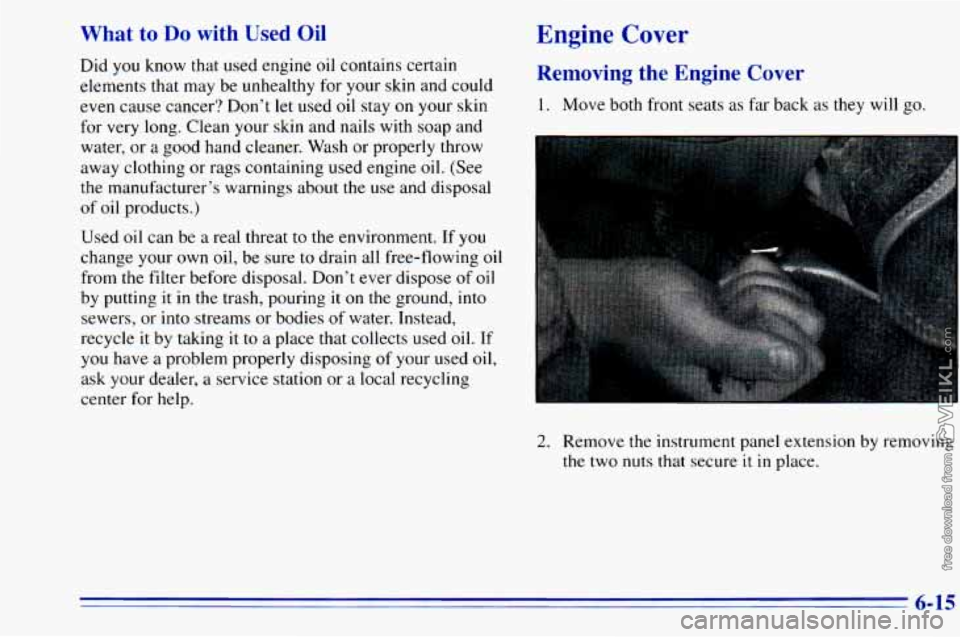
What to Do with Used Oil
Did you know that used engine oil contains certain
elements that may be unhealthy for your skin and could
even cause cancer? Don’t let used
oil stay on your skin
for very long. Clean your skin and nails with soap and
water, or a good hand cleaner. Wash or properly throw
away clothing or rags containing used engine oil. (See
the manufacturer’s warnings about
the use and disposal
of
oil products.)
Engine Cover
Removing the Engine Cover
1. Move both front seats as far back as they will go.
Used oil can be a real threat to the environment.
If you
change your own oil, be sure to drain all free-flowing
oil
from the filter before disposal. Don’t ever dispose of oil
by putting
it in the trash, pouring it on the ground, into
sewers, or into streams or bodies of water. Instead,
recycle
it by taking it to a place that collects used oil. If
you have a problem properly disposing of your used oil,
ask your dealer, a service station or a local recycling
center
for help.
2. Remove the instrument panel extension
by removing
the two nuts that secure it in place.
6-15
Page 367 of 372
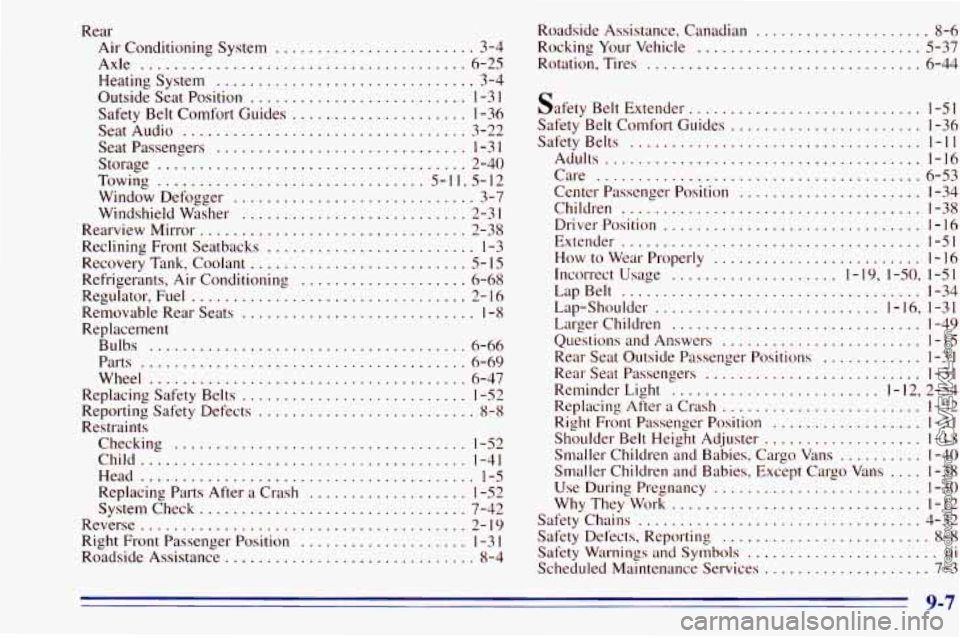
Rear Air Conditioning System
.................... 3-4
Axle
....................................... 6-25
Heating System
............................... 3-4
Outside Seat Position
.......................... 1-3 I
Safety Belt Comfort Guides ..................... 1-36
SeatAudio
.................................. 3-22
Seatpassengers
.............................. 1-31
Storage
..................................... 2-40
Towing
................................ 5.11. 5.12
Window Defogger
............................. 3-7
Windshield Washer
........................... 2-3 I
Rearview Mirror ................................ 2-38
Reclining Front Seatbacks
......................... 1-3
Recovery Tank, Coolant
.......................... 5- 15
Refrigerants. Air Conditioning
.................... 6-68
Regulator.
Fuel ................................. 2- 16
Removable Rear Seats ............................ 1-8
Replacement Bulbs
...................................... 6-66
Parts
....................................... 6-69
Wheel
...................................... 6-47
Replacing Safety Belts
........................... 1-52
Reporting Safety Defects
.......................... 8-8
Restraints Checking
................................... 1-52
Child ....................................... 1-41
Head
........................................ 1-5
Replacing Parts After
a Crash ................... 1-52
Systemcheck
................................ 7-42
Reverse
....................................... 2-19
Right Front Passenger Position
.................... 1-3 I
Roadside Assistance .............................. 8-4 Roadside Assistance. Canadian
......... ....... 8-6
Rocking Your Vehicle
........................... 5-37
Rotation. Tires
...................... ...... 6-44
Safety Belt Extender
............................ 1-51
Safety Belt Comfort Guides
....................... 1-36
Safety Belts
................................... 1 . 11
Adults ...................................... 1-16
Care
....................................... 6-53
Center Passenger Position
...................... 1-34
Children
.................................... 1-38
Driver Position
............................... 1-16
Extender
.................................... 1-51
How
to Wear Properly ......................... 1-16
Incorrect Usage
.................... 1.19. 1-50, 1-51
LapBelt
.................................... 1-34
Lap-Shoulder
........................... 1 . 16, 1-3 1
Questions and Answers ........................ 1 . 15
Rear Seat Outside Passenger Positions
............ 1-31
Rear Seat Passengers
.......................... 1-31
Reminder Light
......................... 1 - 12. 2-54
Replacing Atter
a Crash ........................ 1-52
Right Front Passenger Position .................. 1-31
Shoulder Belt Height Adjuster
................... 1 . 18
Smaller Children and Babies. Cargo Vans .......... 1-40
Smaller Children and Babies. Except Cargo Vans
.... 1-38
Use During Pregnancy
......................... 1-30
WhyThey Work
.............................. 1-12
Safety Defects. Reporting ......................... 8-8
Safety Warnings and Symbols
....................... 111
Scheduled Maintenance Services .................... 7-3
Larger Children
.............................. 1-49
Safety Chains
.................................. 4-32
...
9-7